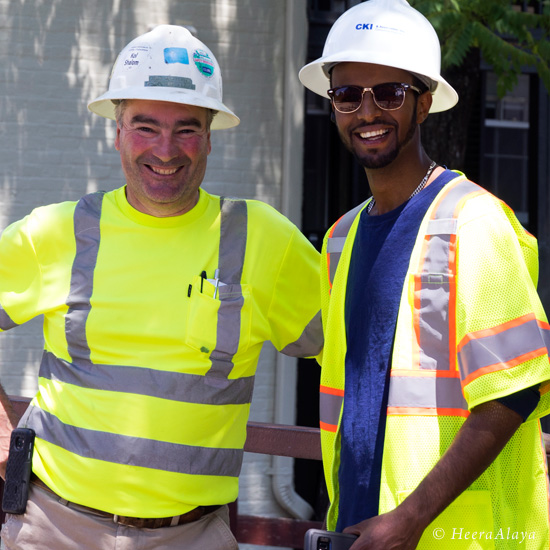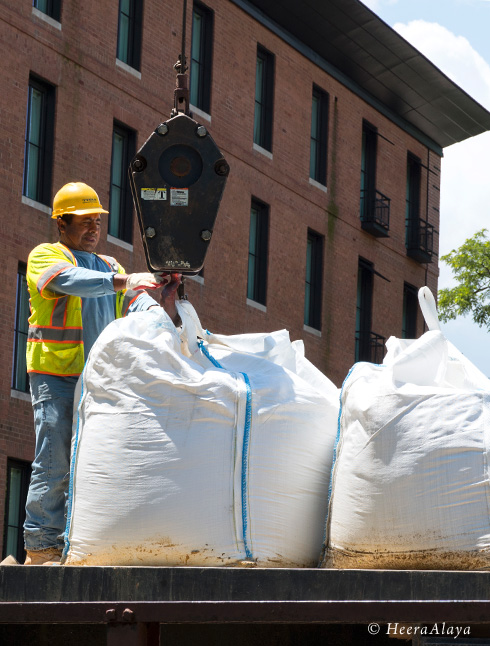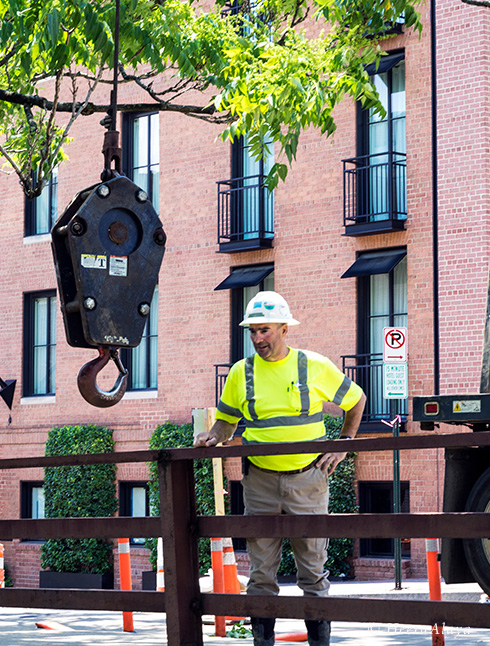
OPEN WINDOWS | Arteries
January 1st, 2021
“Everybody has their responsibility.
That’s how we grow together.
If I am not here, you won’t be here.”
MASTI
Construction inspector, USA
Heera Alaya: Masti, thank you for talking with me.
Masti: Thank you. This is the first time someone has shown interest in us, and I welcome the opportunity to speak with you.
Who are the different crew members, and on what project are you working?
We are all construction workers. For example, I am an inspector on this job, [pointing to his colleagues], and he is the foreman, those guys are the flaggers, and the men in the canal are workers.
This old bridge (built over 150 years ago) has some structural problems that make it unsafe. So we will close it, take it apart, and replace it with a new one.
Can people cross over on foot?
We first have to build a small pedestrian bridge. Then, we will close down the bridge and start dismantling it.
Are you going to remove the entire bridge?
Yes. But because this is a historic bridge, we will store the cast-iron pier—it won’t support any structure—and bring it back when we are done rebuilding the new bridge.
Interesting.
We will do the same with the masonries—remove them and place them right back.
It sounds like an extensive project that demands a great deal of planning.
It is [demanding and extensive].
How long is the project going to take?
The project will take a year and a half.
And you have already started.
Yes.
What are the different phases?
Do you see the big white bags [pointing to the bags placed in the canal]?
Yes.
These white bags are full of sand. We shut down the water way back in the canal. Now we are going to let the water come through because there is life in the canal—fishes and everything—
Ducks and ducklings, too.
Yes, ducks, too. And the more we keep the canal without water, the grass will grow, and mosquitoes will increase and affect the people, so we will let the water come through and stop it right here, by the temporary dam. We don’t want the water to enter the working space while reconstructing the bridge.
These gnats and mosquitoes are shredding me; I can well imagine the crews’ plight.
It’s bad [the gnats and mosquitoes].
How do you ensure the water doesn’t seep through to the area where the crew works?
The water can’t seep through—these watertight sandbags are heavy. And this is a cofferdam—
A cofferdam? What is that?
You are very curious. A cofferdam is a temporary arrangement built to enclose an area where we can work. We pump out any water and make the area dry.
How wide is this dam, and how long did it take to build it?
The dam is 54 feet wide and took about three days to build. We have cranes—like the one you see—that pick up these sandbags and place them down in the canal. The mini excavator, that yellow one down there, arranges the sandbags.
How many crew members are working on this phase?
We have eight men on-site—two flaggers to stop the traffic (since we have only one lane now), a crane driver, the foreman, three men who help the foreman arrange the dam and me. And we will have more people as this project progresses.
You mentioned letting the water come downstream. Is the water controlled upstream?
Yes. If the water wasn’t shut upstream, the water level would have been pretty high–at least close to the sandbags.
The area has to be reasonably dry to start work. When did you shut off the water?
This area—of turning off the water—is taken care of by the National Park Service.
Oh, it’s a well-coordinated process—the National Park Service turns off the water in time for you to take over and start work.
That’s right.




What time does your crew get to this site?
We arrive by 7:00 am. We can work from 7:00 am to 7:00 pm, Monday through Friday, and we must get special permission on Saturdays.
What is their country of origin [the crew members]? You are originally from Ethiopia, and another crew member told me he is from Mexico—
There are many Portuguese and Spanish people, and also from El Salvador and Guatemala.
How difficult is the job your crew is performing?
It’s pretty hard and risky. When the construction crew works in these areas—on a bridge with water, your life is in jeopardy. The crew has to go down the ladder and hold the crane to manoeuvre the sandbags going down.
My job is easy as I inspect—I have to oversee what is going on in the right place, ensure the crew uses the suitable material, and ensure there is no accident. When the crew come in the morning, they carry equipment and huge signs on their shoulder and place them in the correct positions to inform society that there is construction ahead—to prepare the public to deal with only one lane.
The construction crew also works through harsh weather conditions, rain or shine.
That’s right.
A few moments back, I asked one of the crew members, who was having lunch, if I could sit next to him on the pavement to talk; he was gracious and invited me to sit. It was a humbling moment—to see how hard these men work and they sit right on the pavement to eat lunch.
Thank you. Few people appreciate what we are doing now, but most do not. Everybody is rushing; they care only about themselves. But if you look at what we are doing here, you will see that we are not only working to make money but also making everything safe. These guys [the crew] have a life, too—they have families and want to go home safe.
What time do the construction workers leave their homes to start a shift at 7:00 am?
5:00 am or 6:00 am, most likely 5:00 am, because first, they must go from their house to the company in their vehicle, load up with equipment on the company vehicle for that day’s specific job and arrive at the site.
It would be safe to assume that after the site packs up, the crew goes back to the company—to offload the equipment—after which they head home, putting them home around 9:00 pm.
That’s true, and it depends on where these construction guys live; some live very far away, so it’s much harder for them.
I wake up at 5.30 am every day. And since I don’t have to go to a company, I drive here directly.
How many breaks does your crew get through the day?
We don’t have structured breaks; we eat when we have time, wherever possible, like you saw me when I was eating in the truck. We don’t have time to wash our hands; we use paper towels.
What does your crew do for drinking water?
If they want to drink water, we carry it with us; they can have it or buy something, but it’s so expensive in certain areas that it’s better to bring it from home. Most of these construction guys and those at the top make $20 an hour, and a pizza will be $15, which is not affordable.
Construction work is really tough. You don’t have time for your family, Monday through Friday, and sometimes they might work on Saturday,
So Sunday is their only day off?
Yeah.
What do you do when it rains, especially wet ground projects?
For rain and snow, we must ensure erosion and sediment control plans.
What are erosion and sediment control plans?
We must ensure that nothing from the construction site spills onto the road or the nearby establishments. We ensure no leakage from the project site that will damage nearby areas.
Does the crew work when it snows heavily?
The crew doesn’t work on heavy snow days; they stay home because the company doesn’t want to pay them. To get paid, the crew has to be on-site and working. This is true for everyone in construction. When you work with the company for 30 or 40 years, they put you on salary. But on snow days, you must work inside; give the company 40 hours a week to get a salaried job; it’s tough.

What challenges do you face as an inspector?
For me, the challenges are not just about the crew on-site; it’s also about the community—people who live and run establishments near the site areas and manage traffic flow. When people park here and there [near the construction site], the flaggers become tired, and sometimes the flaggers and drivers might start fighting. You see that guy–the flagger–he’s going to be there the whole day, and he’s going to be tired. A vehicle owner and the flagger will throw words at each other, and I have to tell the flagger to calm down and find the driver a nice space to park for a minute; this is part of my job, too.
It can prove to be challenging to handle people.
Yeah. So it’s not only about the project and the materials; the people come first. The crew can’t use things that are not allowed. I won’t say anything, but since I am the one who approves everything, I will not pay for it. But if they do something that could affect the community, I can shut down the job immediately.
Wow. That’s some authority vested in your position as an inspector.
Yeah. But we try to work together. For example, the foreman has been working for this company for 32 years, and we worked together on a parkway project; I have known him for a long time. [Pointing to the foreman] That guy over there, can you see him?
Yes, I met the foreman; he is a pleasant person.
It’s nice of you to say hello to the crew. The foreman [who is from Portugal] is a humble man; I have never seen him get mad. He [the foreman] is really nice, and the guys who work with him love him.
What are the responsibilities of a foreman?
The foreman is the main man; he is the project boss.
So, the crew has to take orders from the foreman.
Yeah. And if there is a problem, only I can talk to the foreman, not the crew.
The foreman has been with the company for 32 years and is salaried.
Yes. But still, on salary, you have to work 50 hours; they don’t pay you overtime. You end up working 60 hours; that’s the disadvantage.
Construction is difficult. For example, I have a degree in Civil Engineering but am studying IT [Information technology] because construction is not paying good money. Not only that, but your life is also always in danger. By 60 years, most crew have had hip or spinal cord surgery.
How young are construction workers when they start?
The foreman started working 30 years ago; he must be 52 now.
The foreman started as a construction worker and worked his way up.
That’s true.
On my last project, a guy told me he started working for the company (not this one, another one) when he was 16. And he gets paid only $22. After 22 years, that’s a small amount of money to give.
How would you like attitudes to change towards people in the construction business?
When I was studying, medical students on campus claimed they were more important because they saved lives. The rest of us students would joke, “Okay, you can save one person at a time in an hour or two hours. But we can kill hundreds of people in a second just by building a bridge with a small mistake. And you can’t work unless we first build the hospital.” Everyone works together, which is beautiful; we must integrate.
People try to show you that they are better. Life doesn’t work that way. Everybody has their responsibility; we live together. That’s how we grow together. If I am not here, you won’t be here. I have a small contribution to all the people here.
True.
I have to manage traffic so people can safely get from work to home.
How do you address on-site injuries? Do you have a first aid kit?
I don’t have a first aid kit, but the crew has to have one, and if the injury is serious, we take them to the hospital.
Will there be an inaugural ceremony for this bridge?
I guess so.
Will the crew and you be invited?
I am not sure.
I ask because men in suits often step in to claim credit and drink champagne, which is unfortunate. Would you like the system to change to where we celebrate the right people?
Of course, it will mean a lot if they recognise the crew’s work, even if it’s giving a certificate. One of my mentors, Jerry, worked in my previous company for 40 years. Every time Jerry finished a job, he would take a penny and stick it to the ground. So if you see a penny around a bridge, you know Jerry built it.
Interesting.
Even the company owners didn’t value Jerry. In the 40 years Jerry worked, the company switched three different owners, and though Jerry knows the company’s history, no one credits him. One thing Jerry told me: “Some people think the world revolves around them; no, we are part of a team. The world is a circle, and we are part of the arc; we are not in the middle.” We have to be nice; it doesn’t cost a thing.
When I expressed my interest in talking with you, you agreed. Why?
What do I lose in talking to you?
That’s a great attitude.
Everything has a reason. You have a reason to come to me, and I will take it and explain our work. If you do something good for people, you will get it back. It makes you happy.
Sometimes, we are scared to approach people.
That’s true. People go by and ask me, “What’s going on?” And maybe, “Where are you from? You have a different accent.” When I tell them I am from Ethiopia, people say, “Okay,” and leave. And I want to ask them if they know about Ethiopia.
Chances are they don’t [know about Ethiopia] and don’t want to learn anything about the world.
That’s true. I am not judging, but most Americans know only about America, not the rest of the world, unlike Europeans who know about everything.




